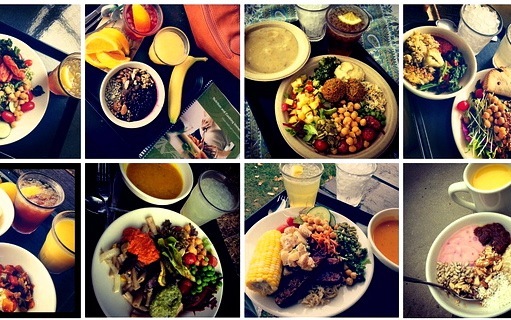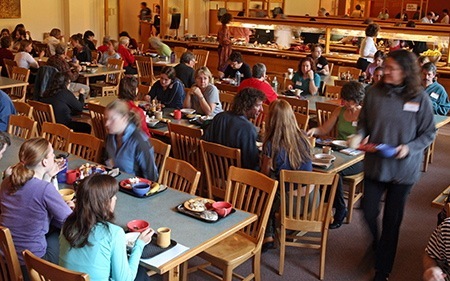4.1.14 Make Peace

As I write this, there are two tiny ants crawling around on my desk: proof positive that the world is waking up and spring is imminent. I heard the low trill of an Eastern screech owl the other morning and witnessed four robins sprinting across the lawn. There have already been rumored sightings of bears. Soon the frogs will come out of their deep thaw and the woodland orgies will commence. Tempers can run hot at this time of year, as even emotions lie dormant and come bubbling up as we begin to move and shake our creaky limbs. Be gentle with yourself, and with others. Stretch. Stimulate your blood flow by taking a natural bristle brush or a dry loofah and brushing your skin in long strokes toward the heart. Lighten the load on your organs (especially the liver and gall bladder) by eating fewer processed foods and meat and increasing your intake of greens, especially the bitter ones like dandelion and the chicories.
I was lucky enough to jumpstart my seasonal transition with a few days at Kripalu, a wonderful yoga and wellness center in Lenox, Mass. I've been there several times and really appreciate all it has to offer: yoga, massage, hiking, meditation, privacy, community and delicious, healthy food. As it happened, my reading for the Berkshire Festival of Women Writers took place there on the last day of my stay, so it was incredibly serendipitous and convenient.

Though Kripalu is not a luxury spa along the lines of Canyon Ranch, its lovely, simple accommodations are not exactly cheap. They are made more accessible by the options available—either our own room with a private bath; a shared room; or larger communal rooms. I have always opted for my own room, but would consider another arrangement if I needed to. Many seminars and courses are on offer, and you can schedule your stay around participating in one on yoga, say, or meditation or nutrition, or you can just show up and use the facilities as you wish through the R&R program, taking advantage of daily yoga classes, guided hikes and other perks.

Kripalu is open to both sexes, though women have outnumbered men whenever I've been there. Yoga is offered at 3 levels of intensity (beginner, moderate and vigorous), three times a day: 6:30, 12:15 and 4:30. There is a nice gym, a healing arts center with amazingly accomplished bodyworkers, and plenty of cozy nooks and crannies for reading your book, napping or just staring out the window at the gorgeous panoramic views. A café has the only internet access and coffee, and there is also a large boutique bursting with everything from yoga clothes and essential oils to crystals and Ram Dass CDs, should you need a little retail therapy. Overall, the vibe is pretty crunchy, but it's also low-key, nurturing and very non-judgmental.

One of the many highlights of a stay at Kripalu is the food. It's served cafeteria-style in a large dining hall but the resemblance to industrial food ends there. All three daily meals are lovingly prepared from beautiful ingredients, organic and locally sourced wherever possible. The cuisine is mostly vegetarian, though there are always a few options for meat-eaters. Breakfast is a silent meal, and mindful eating is always encouraged. The food is really healthy, but there is such an abundance that it would be easy to get carried away. I allow myself just one trip through the line—no going back for seconds, no matter how tempting it may be!

I took a few notes when I was there this time so I would remember the set-up:
The long buffet - has a soup option, a salad bar (with house-made dressings, including a delicious ume-scallion one), and a rotating selection of vegan and vegetarian dishes. I think my favorite day was Taco Tuesday! We had organic taco shells (the boxed kind which were actually so good!) and with them black beans, roasted corn and kale, fresh tomato salsa and guacamole. Another day we had samosas with sauteed mustard greens, cucumber raita, vegetable biryani, curried chickpeas, cilantro chutney and tamarind sauce.
The bread station - with peasant, sesame and olive breads, all made in-house from sourdough starter plus homemade peanut butter (skin-on) and low-sugar preserves (apricot and raspberry); there is also a gluten-free bread station!
The Buddha Bar is all macrobiotic food and there are at least 6 dishes every day, usually including dal, rice, saag and sauerkraut.
The sandwich station has various cold cuts, cheeses, condiments, sprouts and greens plus those delicious breads again and large tortillas, so you can make sandwiches and quesadillas on the panini presses they have right there!
The fruit station has seasonal choices; this time we had fresh pears, apples, grapefruit and oranges.
There are always two kinds of iced herbal tea; fresh local whole milk and homemade soy milk (and also sometimes masala chai made with these); plus 15 kinds of herbal tea. I drank cup after cup of yogi ginger tea with fresh lemon and a drop of local honey. So restorative!
Anyway, you get the idea—they don't fool around when it comes to quality nourishment! Breakfasts were similarly boutiful and delicious. One of my favorites included a dish that I'm sure I've had had many times before but never really noticed: kitchari.

This delicious mainstay of Indian cuisine consists of a soft porridge of split yellow mung beans (known as dal) and white basmati rice infused with ghee and mild spices. It’s widely prescribed as the primary food in Ayurvedic cleansing therapies because it is said to detoxify the entire system while also kindling the digestive fires. East Indians turn to this fortifying and soothing dish when weakened or sick. In India, it is said that a diet of only kitchari, “the mother of natural healing,” will cure all diseases within 3 weeks.
On Friday, I embark on my own 21-day detox/cleanse, under the mentorship of my inspiring health coach. This means no meat, fowl or fish; no dairy, including eggs; no gluten; no sugar (or honey or molasses); no nightshades (tomatoes, peppers, eggplant); and for me, no nuts, because I'm more and more convinced they just don't agree with me. It also means tons of fresh vegetables and fruits; whole grains (rice, quinoa, buckwheat, millet); seeds (sesame, pumpkin, sunflower); herbs of all sorts, fresh and dried; and a few drops of maple syrup here and there.
Cleanse or no, I recommend this kitchari. At Kripalu, I ate it with a blob of yogurt, a sprinkling of dried coconut and a spoonful of pureed raisins, but it would also be delicious just with lots of chopped cilantro.
*For anyone interested, here follows the piece I read for Who Cares at the Berkshire Festival of Women Writers. I am indebted to my friend Janet for inviting me to be a part of this wonderful event, where I engaged in what I believe to be a very important conversation about who we are in relation to illness, death and dying.
In 1989, when I was 25, I quit my job in New York City and moved back to California to help care for my father as he lay dying of stomach cancer. I arrived with the intention of curing him but, after just a couple of weeks of throwing open the curtains and whipping up smoothies, I was horrified to discover two things: One, I had greatly overestimated my powers. And two, my father had already decided that he was ready to die. It took him three months to do it, and afterward I stayed on with my mother, feeling increasingly helpless as the benign tumor that had been slowly wrapping itself around her spinal cord for the past couple of decades continued to wreak havoc on her motor skills. Six months later, I returned to my life in New York, furious at my father for abandoning us and at myself for doing the same to my mother. But I’m not here to talk about all that.
A decade later, I left New York for Los Angeles, where I met and married a man who turned out to have a fatal cancer. Our two-year marriage was a blur of radiation treatments and experimental chemo. Eventually, the tumors spread to his brain and caused a stroke. He died in hospice care shortly thereafter. I moved back to New York and four months later, my mother died. But, believe it or not, I’m not here to talk about tending to the dying.
I’m here to share my experiences caring for someone whose illness is merely chronic. That someone is George, the next man I fell in love with who, just two years into our relationship, and shortly before we got married, began having severe gastro-intestinal pain. It soon filled his every waking hour, an aggressive and relentless gnawing that sometimes turned into the sharp, stabbing sensations he dubbed “the shiv.” My initial reaction was a deep and silent panic as I waited first for the gastroenterologist, then the infectious disease specialist and finally the neurologist to come back with a fatal diagnosis. But that didn’t happen, and as more consultations and research failed to provide any answer, I entered into completely foreign territory: I didn’t know what to do.
George’s body, though wracked with pain, was essentially sound. He didn’t need me to spoon-feed him, keep track of his meds, or mop his fevered brow. From one perspective (the sane one) this was a good thing. Let’s face it: few things are less sexy than wiping your lover’s ass. But it also made me feel incredibly powerless. Before, when confronted with the suffering of loved ones, I had been the nursemaid, the angel, the rock—challenging-but-heroic roles with a limited run. Now what part could I play? George was so stoic, never complaining or playing the martyr. All he asked of me was reassurance that his pain was not going to define our life. He just wanted to feel normal and to be to seen as the man he still was, despite everything. In all the ways that count, George is the healthiest person I have ever known. He showed me that caretaking, though a very loving act, is not the basis for a marriage.
There is a poem that illustrates this beautifully. I first heard it shortly after my husband died of cancer, recited by the poet in a very moving short film called Hope Is The Thing with Feathers. Here are a few lines from Via Dolorosa by Beau Riley, inspired by his partner’s death from AIDS:
Your needs fall away
like the leaves from the aspen tree
outside our window in the cold
December night. Your table gets
clearer and clearer until we
sit breathing seldom in the dark.
We're down to chapstick and water and love.
Then your lips are too sore, so
we have water and love.
Then your throat is too feeble, so
we have love,
and these useless chrysanthemums
that shine all alone beside me.
It’s one thing to realize that the fight is over when the end is so very near. But chronic illness is a limbo from whose depths you might beg for resolution for all eternity. It’s a constant presence with a monotone intensity that never lets up. According to the CDC, it is defined by a non-self-limited nature (in other words, its course is unknown); by the association with persistent and recurring health problems; and by a duration measured not in days and weeks, but in months and years. It’s not the hellfire of certain death, but, arguably, it’s worse. Six years into a mystery condition that is threatening to leach the vitality from your man, you’ll think nothing of repeated DIY stool transfers, because you would do anything, anything at all, to Just. Make it. Stop. This is totally unlike the heart-rending sprint to the finish line; it’s a grinding slog with no end in sight. For me, only one thing kept the fear, the despair, the anger, the anxiety, the resentment, the exhaustion at bay: love.
George’s pain whittled away at our sex life, but not our intimacy. It blurred our vision of the future, but it couldn’t touch our connection to each other in the moment. Through my practice of yoga, I learned about asmita, the false identification that happens when we mistake the mind, body or senses for the true self, and I realized that neither us of was defined by this circumstance. For all the things that we didn’t have, we still had ourselves and each other. Shored up by this love, our resolve to remain happy didn’t wane. My friend Sara says she doesn’t believe in hope, that hope is fictional. To get through her girlfriend’s illness, she simply, stubbornly persisted in believing that everything would be OK. She’s not religious, but she calls this faith. Mother Teresa says that the fruit of faith is love, so maybe this all circles around to make sense.
Forever is an abstraction that’s hard to grasp, especially when it means enduring something that seems untenable. But somehow, when it’s applied to love everlasting—or marriage—it enters the realm of possibility. Luckily, after nearly 7 years—years in which we persisted in seeking the right treatment—the pain stopped. Thanks to a wise and creative doctor at Johns Hopkins who prescribed a drug called Lyrica, George has been living largely pain-free for the last few months. I don’t think either of us really trusts it yet. We’re still in a kind of shock, quietly braced for the pain to return. But in preparation for whatever comes, we’re continuing to stockpile an arsenal of love.
Kitchari (Mung Bean & Rice Porridge)
- — 1/4 cup yellow moong dahl, rinsed well
- — 1/2 cup white basmati rice, rinsed well
- — 5 cups water
- — 1/2 teaspoon sea salt
- — 2 teaspoons ground cumin
- — 1 teaspoon ground turmeric
- — Pinch freshly ground black pepper
- — Pinch of asafoetida
- — 1 tablespoon ghee, or other oil
- — 1 teaspoon brown mustard seeds
- — 2 tablespoons chopped cilantro
- — Squeeze of lemon
- — Spiced crispy rice
- — Microgreens
Place the mung dal and rice in a medium saucepan with the water and bring to the boil. Add salt and cover. Reduce heat to the lowest setting and simmer while you prepare the spices.
Combine the cumin, turmeric, black pepper and asafoetida in a small bowl.
Heat a small sauté pan over medium-high and add the ghee, allowing it to melt. Add the mustard seeds and stir until they start to sizzle and pop, about 10 seconds. Reduce heat to medium and add the spice mixture. Cook for 30 seconds, stirring constantly so as not to burn the spices. Transfer the hot cooked spice mixture to the cooking rice and dal and mix well.
Continue to cook, stirring occasionally, until a porridge consistency is achieved, about 40 minutes or more.
Serve garnished with lemon wedges, cilantro, crispy rice and microgreens.
 Download Recipe
Download Recipe






19 Comments